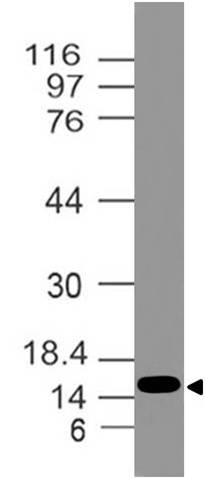Recombinant Human Adiponectin(Discontinued)
Shipping Info:
For estimated delivery dates, please contact us at [email protected]
| Amount : | 25 µg |
| Purification : | Purity:>= 97% by SDS-PAGE gel and HPLC analyses. |
| Content : | This recombinant protein is supplied in lyophilized form. |
| AA sequence : | RGHHHHHHHH ETTTQGPGVL LPLPKGACTG WMAGIPGHPG HNGAPGRDGR DGTPGEKGEK GDPGLIGPKG DIGETGVPGA EGPRGFPGIQ GRKGEPGEGA YVYRSAFSVG LETYVTIPNM PIRFTKIFYN QQNHYDGSTG KFHCNIPGLY YFAYHITVYM KDVKVSLFKK DKAMLFTYDQ YQENNVDQAS GSVLLHLEVG DQVWLQVYGE GERNGLYADN DNDSTFTGFL LYHDTN |
| Alternative Name : | Acrp-30, GBP-28, APM-1, Gelatin-binding protein, AdipoQ |
Source:Â Hi-5 Insect cells
Adiponectin is an adipose-derived secreted protein containing 226 amino acid residues. It is relatively abundant in humans and rodents, accounting for about 0.01% of total plasma protein. The circulating levels of adiponectin are decreased under conditions of obesity, insulin resistance, and type II diabetes. Disruption of adiponectin in mice causes insulin resistance and neointimal formation. Conversely, administration of recombinant adiponectin suppresses hepatic glucose production, and reverses insulin resistance associated with both lipoatrophy and obesity. The protective role of adiponectin is attributed to its anti-inflammatory properties (e.g. ability to suppress expression of TNF-Alpha and class A scavenger receptor in macrophages). Recombinant adiponectin is a multimeric glycoprotein containing amino acids Glu-19 to Asn-244 of the adiponectin precursor protein fused to an N-terminal histidine tag. Monomeric glycosylated adiponectin migrates at an apparent molecular weight of approximately 35.0 kDa by SDS PAGE analysis under reducing conditions. Â The calculated molecular weight of Recombinant Human Adiponectin is 25.9 kDa.
Adiponectin is an adipose-derived secreted protein containing 226 amino acid residues. It is relatively abundant in humans and rodents, accounting for about 0.01% of total plasma protein. The circulating levels of adiponectin are decreased under conditions of obesity, insulin resistance, and type II diabetes. Disruption of adiponectin in mice causes insulin resistance and neointimal formation. Conversely, administration of recombinant adiponectin suppresses hepatic glucose production, and reverses insulin resistance associated with both lipoatrophy and obesity. The protective role of adiponectin is attributed to its anti-inflammatory properties (e.g. ability to suppress expression of TNF-Alpha and class A scavenger receptor in macrophages). Recombinant adiponectin is a multimeric glycoprotein containing amino acids Glu-19 to Asn-244 of the adiponectin precursor protein fused to an N-terminal histidine tag. Monomeric glycosylated adiponectin migrates at an apparent molecular weight of approximately 35.0 kDa by SDS PAGE analysis under reducing conditions. Â The calculated molecular weight of Recombinant Human Adiponectin is 25.9 kDa.
Determined by a cytotoxic assay using M1 cells. The ED50 for this effect is 3.0-6.0 µg/ml.
For Research Use Only. Not for use in diagnostic/therapeutics procedures.
|
There are currently no product reviews
|

















.png)









